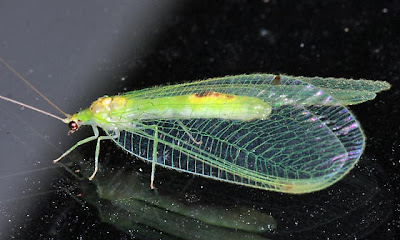Some of those little bugs with flimsy wings that fly around the porch light at night seem innocent enough, especially if you identify them with the gentle name of "lacewing." Even though they are harmless, they bother many people less attuned to nature. Dave Barry defines nature as "anything you would kill if it got inside your house."
The specimen above is one of the many green lacewing species in the
Chrysopinae family. I believe this is
Leucochrysa insularis,
although identification down to species level is challenging to even
experienced taxonomists. I will let you do the comparison yourself with
the picture below.
Actually, these innocent looking flying things are serious predators of many bugs that "bug" us. The adults come out around sunset and feed during the night on aphids, mites and other tiny arthropods as well as nectar and aphids' honeydew. Some species have symbiotic yeast living in their gut to digest their food, similar to the bacteria in a cow's rumen. They have good hearing, enabled by tympanal organs on their forewings. Some species can even pick up the echo locating signals of bats in time to take evasive action.
Although identifying species of lacewings is a challenge, fortunately, the animals themselves are able to overcome this problem by courtship rituals, vibrating their bodies and the leaf they are on to produce species specific rhythms. One pair of closely related species are only differentiated by listening to recordings of their vibrations.
Lacewing eggs are deposited singularly or in small clumps, hanging by a short thread on the underside of a leaf. They are usually placed around a supply of aphids, a convenient snack when the hungry larvae emerge and climb up the stalk.
 |
| Green lacewing eggs- Chrysopidae family- Tom Murray |
Larvae are predatory,
taking on eggs, pupae and even larger insects. They are especially fond of aphids, and are sometimes called 'aphid lions.' They are equipped with a set of jaws shaped like old fashioned ice tongs which penetrate their victims, inject digestive juices and then suck them dry. Some species can digest an aphid in 90 seconds!
 |
| L. insularis larva -Jim Kalisch CC |
Many species of lacewing larvae have hairs that help hold trash and the empty remnants of prey such as their favorite aphids as well as other debris. This decoration helps to camouflage the larvae from predators such as birds and may serve to defend them from the ants which are protecting their aphid honeydew herd. These larvae are literally crawling trash bins.
 |
| Decorated larva- Wikimedia |
The next time you brush away a fluttering insect by your porch light, be gentle. It is probably just out on the prowl, testing you for aphids.
As discussed in a recent blog on the wavy-lined emerald moth, lots of other caterpillars decorate their bodies, presumable as camouflage. Bug Girl's Blog
has an interesting variation on the theme. A caterpillar native to
Australia retains its dried head remnant after each molt, stacking them
up like a hat from a Mardi Gras parade.
November 1, 2016 - Linda Bower posted a video of a debris carrying larva.







